

Compact Muon Solenoid
LHC, CERN
| CMS-EXO-16-004 ; CERN-EP-2017-330 | ||
| Search for decays of stopped exotic long-lived particles produced in proton-proton collisions at $\sqrt{s} = $ 13 TeV | ||
| CMS Collaboration | ||
| 31 December 2017 | ||
| JHEP 05 (2018) 127 | ||
| Abstract: A search is presented for the decays of heavy exotic long-lived particles (LLPs) that are produced in proton-proton collisions at a center-of-mass energy of 13 TeV at the CERN LHC and come to rest in the CMS detector. Their decays would be visible during periods of time well separated from proton-proton collisions. Two decay scenarios of stopped LLPs are explored: a hadronic decay detected in the calorimeter and a decay into muons detected in the muon system. The calorimeter (muon) search covers a period of sensitivity totaling 721 (744) hours in 38.6 (39.0) fb$^{-1}$ of data collected by the CMS detector in 2015 and 2016. The results are interpreted in several scenarios that predict LLPs. Production cross section limits are set as a function of the mean proper lifetime and the mass of the LLPs, for lifetimes between 100 ns and 10 days. These are the most stringent limits to date on the mass of hadronically decaying stopped LLPs, and this is the first search at the LHC for stopped LLPs that decay to muons. | ||
| Links: e-print arXiv:1801.00359 [hep-ex] (PDF) ; CDS record ; inSPIRE record ; HepData record ; CADI line (restricted) ; | ||
| Figures | |
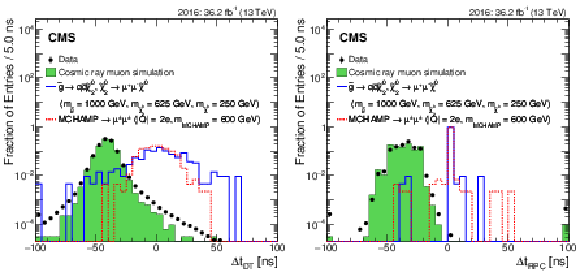
png pdf |
Figure 1:
The $\Delta t_{\text {DT}}$ (left) and $\Delta t_{\text {RPC}}$ (right) distributions for 2016 data, MC simulated cosmic ray muon, 1000 GeV gluino signal, and 600 GeV MCHAMP signal events, for the muon search. The events plotted pass a subset of the full analysis selection that is designed to select good-quality DSA muon tracks but does not reject the cosmic ray muon background. The number of cosmic ray muon background events is greatly reduced when the full selection is applied, as we require $\Delta t_{\text {DT}} > -20$ ns and $\Delta t_{\text {RPC}} > -7.5$ ns. The gray bands indicate the statistical uncertainty in the simulation. The histograms are normalized to unit area. |
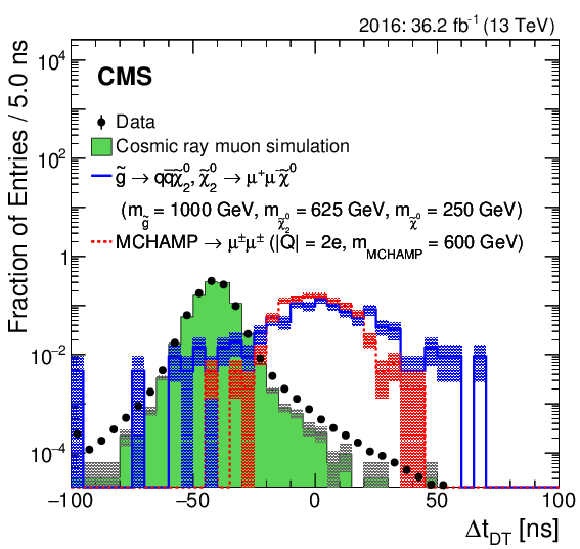
png pdf |
Figure 1-a:
The $\Delta t_{\text {DT}}$ distribution for 2016 data, MC simulated cosmic ray muon, 1000 GeV gluino signal, and 600 GeV MCHAMP signal events, for the muon search. The events plotted pass a subset of the full analysis selection that is designed to select good-quality DSA muon tracks but does not reject the cosmic ray muon background. The number of cosmic ray muon background events is greatly reduced when the full selection is applied, as we require $\Delta t_{\text {DT}} > -20$ ns and $\Delta t_{\text {RPC}} > -7.5$ ns. The gray bands indicate the statistical uncertainty in the simulation. The histograms are normalized to unit area. |
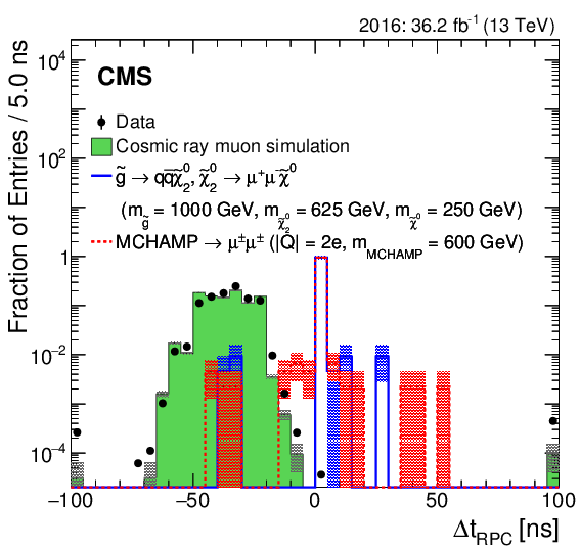
png pdf |
Figure 1-b:
The $\Delta t_{\text {RPC}}$ distribution for 2016 data, MC simulated cosmic ray muon, 1000 GeV gluino signal, and 600 GeV MCHAMP signal events, for the muon search. The events plotted pass a subset of the full analysis selection that is designed to select good-quality DSA muon tracks but does not reject the cosmic ray muon background. The number of cosmic ray muon background events is greatly reduced when the full selection is applied, as we require $\Delta t_{\text {DT}} > -20$ ns and $\Delta t_{\text {RPC}} > -7.5$ ns. The gray bands indicate the statistical uncertainty in the simulation. The histograms are normalized to unit area. |

png pdf |
Figure 2:
The $\varepsilon _{\text {reco}}$ values as a function of $E_{{\mathrm {g}}}$ or $E_{{\mathrm {t}}}$ (left), and $m_{\tilde{\mathrm{g}}} - m_{\tilde{\chi}^0_2}$ (right), for $ \tilde{\mathrm{g}}$ and $ \tilde{\mathrm{t}} $ R-hadrons that stop in the EB or HB, in the MC simulation, for the calorimeter search. The $\varepsilon _{\text {reco}}$ values are plotted for the two-body gluino and top squark decays (left) and for the three-body gluino decay (right). The shaded bands correspond to the systematic uncertainties, which are described in Section 7. |

png pdf |
Figure 2-a:
The $\varepsilon _{\text {reco}}$ values as a function of $E_{{\mathrm {g}}}$ or $E_{{\mathrm {t}}}$ for $ \tilde{\mathrm{g}}$ and $ \tilde{\mathrm{t}} $ R-hadrons that stop in the EB or HB, in the MC simulation, for the calorimeter search. The $\varepsilon _{\text {reco}}$ values are plotted for the two-body gluino and top squark decays. The shaded bands correspond to the systematic uncertainties, which are described in Section 7. |

png pdf |
Figure 2-b:
The $\varepsilon _{\text {reco}}$ values as a function of $m_{\tilde{\mathrm{g}}} - m_{\tilde{\chi}^0_2}$ for $ \tilde{\mathrm{g}}$ and $ \tilde{\mathrm{t}} $ R-hadrons that stop in the EB or HB, in the MC simulation, for the calorimeter search. The $\varepsilon _{\text {reco}}$ values are plotted for the three-body gluino decay. The shaded bands correspond to the systematic uncertainties, which are described in Section 7. |

png pdf |
Figure 3:
The background extrapolation for the muon search. The integral of the fit function to $\Delta t_{\text {DT}}$ with the sum of two Gaussian distributions and a Crystal Ball function, for $\Delta t_{\text {DT}} > -20$ ns, is plotted as a function of the lower $\Delta t_{\text {RPC}}$ selection, for 2015 (red squares) and 2016 (black circles) data. The points are fitted with an error function and used to extrapolate to the signal region, which is defined as $\Delta t_{\text {RPC}} > -7.5$ ns. |
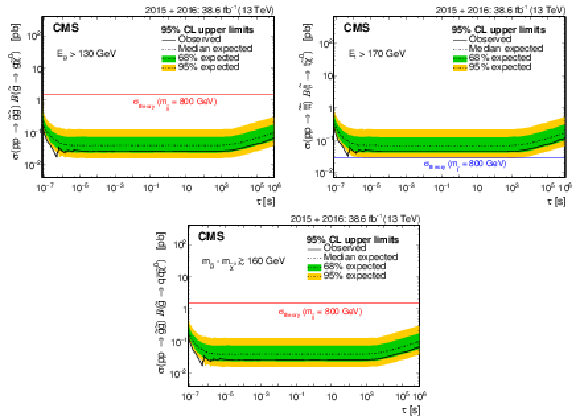
png pdf |
Figure 4:
The 95% CL upper limits on $\mathcal {B}\sigma $ for gluino and top squark pair production, using the cloud model of R-hadron interactions, as a function of lifetime, for combined 2015 and 2016 data for the calorimeter search. We show gluinos that undergo a two-body decay (upper left), top squarks that undergo a two-body decay (upper right), and gluinos that undergo a three-body decay (lower). The discontinuous structure observed between $10^{-7}$ and $10^{-5}$ s is due to the increase of the number of observed events in the search window as the lifetime increases. The theory lines assume $\mathcal {B}= $ 100%. |

png pdf |
Figure 4-a:
The 95% CL upper limits on $\mathcal {B}\sigma $ for gluino and top squark pair production, using the cloud model of R-hadron interactions, as a function of lifetime, for combined 2015 and 2016 data for the calorimeter search. We show gluinos that undergo a two-body decay. The discontinuous structure observed between $10^{-7}$ and $10^{-5}$ s is due to the increase of the number of observed events in the search window as the lifetime increases. The theory lines assume $\mathcal {B}= $ 100%. |
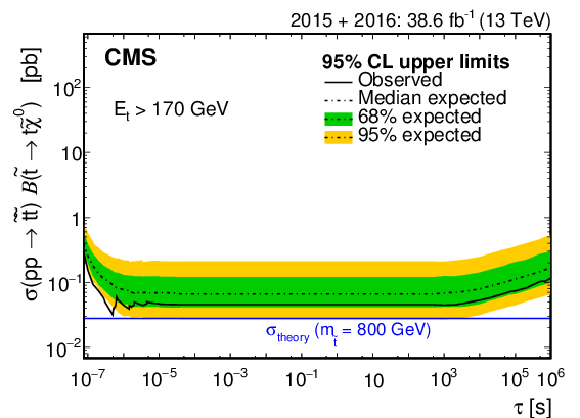
png pdf |
Figure 4-b:
The 95% CL upper limits on $\mathcal {B}\sigma $ for gluino and top squark pair production, using the cloud model of R-hadron interactions, as a function of lifetime, for combined 2015 and 2016 data for the calorimeter search. We show top squarks that undergo a two-body decay. The discontinuous structure observed between $10^{-7}$ and $10^{-5}$ s is due to the increase of the number of observed events in the search window as the lifetime increases. The theory lines assume $\mathcal {B}= $ 100%. |
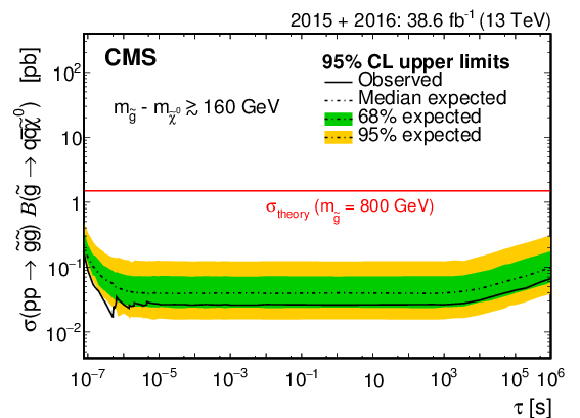
png pdf |
Figure 4-c:
The 95% CL upper limits on $\mathcal {B}\sigma $ for gluino and top squark pair production, using the cloud model of R-hadron interactions, as a function of lifetime, for combined 2015 and 2016 data for the calorimeter search. We show gluinos that undergo a three-body decay. The discontinuous structure observed between $10^{-7}$ and $10^{-5}$ s is due to the increase of the number of observed events in the search window as the lifetime increases. The theory lines assume $\mathcal {B}= $ 100%. |

png pdf |
Figure 5:
The 95% CL upper limits on the gluino and top squark mass, using the cloud model of R-hadron interactions, as a function of lifetime, for combined 2015 and 2016 data for the calorimeter search. We show gluinos and top squarks that undergo a two-body decay (left) and gluinos that undergo a three-body decay (right). The discontinuous structure observed between $10^{-7}$ and $10^{-5}$ s is due to the increase of the number of observed events in the search window as the lifetime increases. |

png pdf |
Figure 5-a:
The 95% CL upper limits on the gluino and top squark mass, using the cloud model of R-hadron interactions, as a function of lifetime, for combined 2015 and 2016 data for the calorimeter search. We show gluinos and top squarks that undergo a two-body decay. The discontinuous structure observed between $10^{-7}$ and $10^{-5}$ s is due to the increase of the number of observed events in the search window as the lifetime increases. |
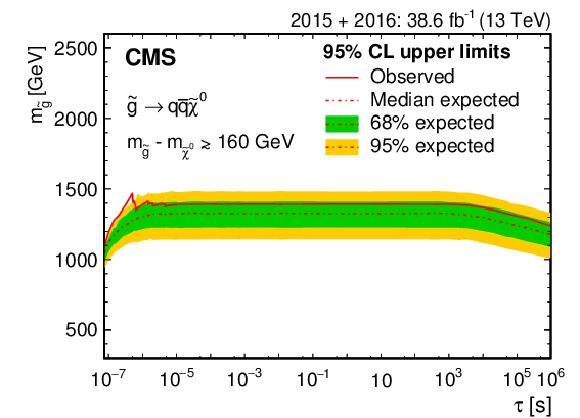
png pdf |
Figure 5-b:
The 95% CL upper limits on the gluino and top squark mass, using the cloud model of R-hadron interactions, as a function of lifetime, for combined 2015 and 2016 data for the calorimeter search. We show gluinos that undergo a three-body decay. The discontinuous structure observed between $10^{-7}$ and $10^{-5}$ s is due to the increase of the number of observed events in the search window as the lifetime increases. |

png pdf |
Figure 6:
The 95% CL upper limits in the neutralino mass vs. gluino (top squark) mass plane, for lifetimes between 10 $\mu$s and 1000 s, for combined 2015 and 2016 data for the calorimeter search. The color map indicates the 95% CL upper limits on $\mathcal {B}\sigma $. The mostly triangular region defined by the black solid (dashed) line shows the excluded observed (expected) region. We show gluinos that undergo a two-body decay (upper left), top squarks that undergo a two-body decay (upper right), and gluinos that undergo a three-body decay (lower). |
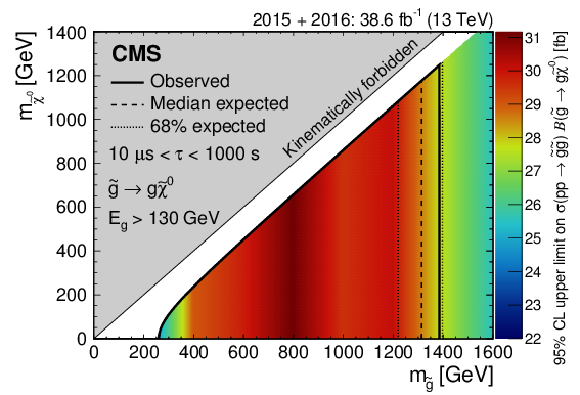
png pdf |
Figure 6-a:
The 95% CL upper limits in the neutralino mass vs. gluino (top squark) mass plane, for lifetimes between 10 $\mu$s and 1000 s, for combined 2015 and 2016 data for the calorimeter search. The color map indicates the 95% CL upper limits on $\mathcal {B}\sigma $. The mostly triangular region defined by the black solid (dashed) line shows the excluded observed (expected) region. We show gluinos that undergo a two-body decay. |
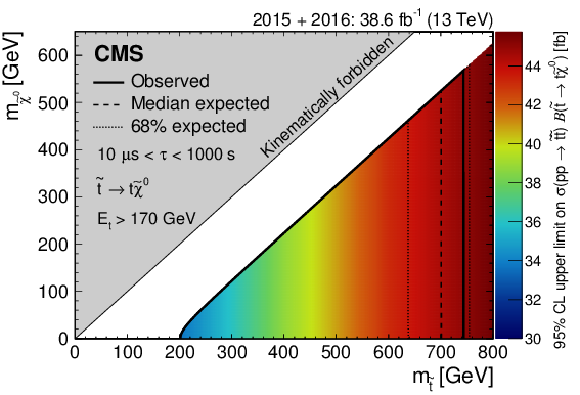
png pdf |
Figure 6-b:
The 95% CL upper limits in the neutralino mass vs. gluino (top squark) mass plane, for lifetimes between 10 $\mu$s and 1000 s, for combined 2015 and 2016 data for the calorimeter search. The color map indicates the 95% CL upper limits on $\mathcal {B}\sigma $. The mostly triangular region defined by the black solid (dashed) line shows the excluded observed (expected) region. We show top squarks that undergo a two-body decay. |
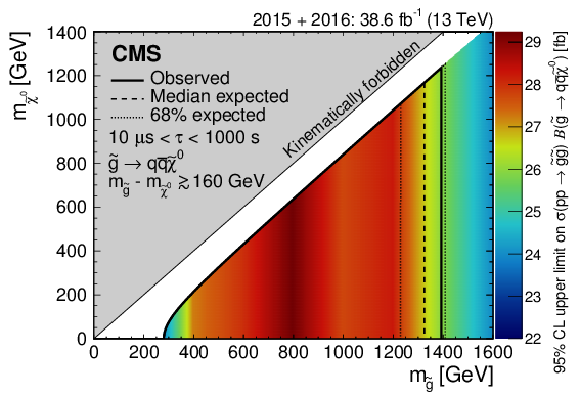
png pdf |
Figure 6-c:
The 95% CL upper limits in the neutralino mass vs. gluino (top squark) mass plane, for lifetimes between 10 $\mu$s and 1000 s, for combined 2015 and 2016 data for the calorimeter search. The color map indicates the 95% CL upper limits on $\mathcal {B}\sigma $. The mostly triangular region defined by the black solid (dashed) line shows the excluded observed (expected) region. We show gluinos that undergo a three-body decay. |
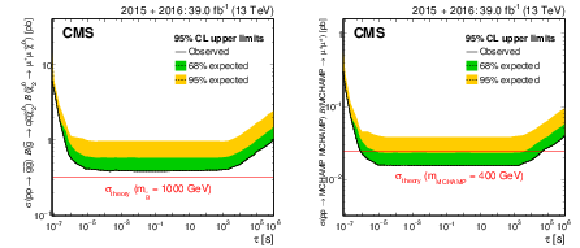
png pdf |
Figure 7:
The 95% CL upper limits on $\mathcal {B}\sigma $ for 1000 GeV gluino (left) and 400 GeV MCHAMP (right) pair production as a function of lifetime, for combined 2015 and 2016 data for the muon search. The theory lines assume $\mathcal {B}= $ 100%. |
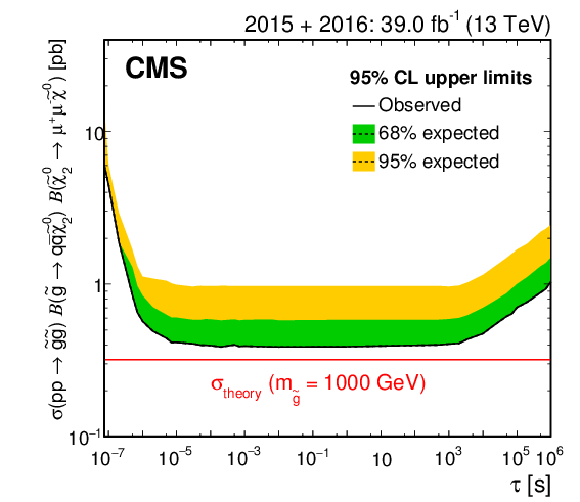
png pdf |
Figure 7-a:
The 95% CL upper limits on $\mathcal {B}\sigma $ for 1000 GeV gluino pair production as a function of lifetime, for combined 2015 and 2016 data for the muon search. The theory lines assume $\mathcal {B}= $ 100%. |
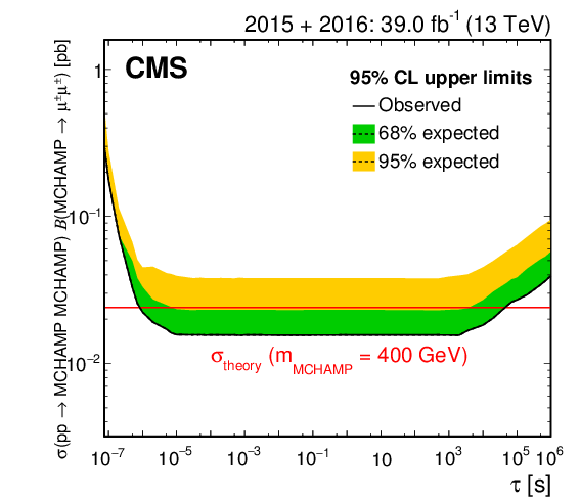
png pdf |
Figure 7-b:
The 95% CL upper limits on $\mathcal {B}\sigma $ for 400 GeV MCHAMP pair production as a function of lifetime, for combined 2015 and 2016 data for the muon search. The theory lines assume $\mathcal {B}= $ 100%. |

png pdf |
Figure 8:
95% CL upper limits on $\mathcal {B}\sigma $ for gluino (left) and MCHAMP (right) pair production as a function of mass, for lifetimes between 10 $\mu$s and 1000 s, for combined 2015 and 2016 data for the muon search. The theory curves assume $\mathcal {B}= $ 100%. |
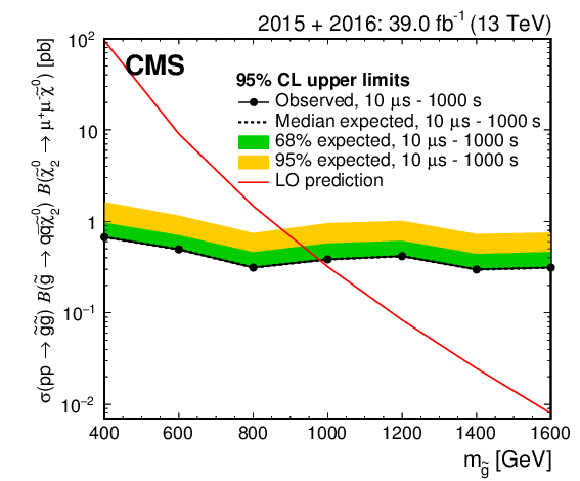
png pdf |
Figure 8-a:
95% CL upper limits on $\mathcal {B}\sigma $ for gluino pair production as a function of mass, for lifetimes between 10 $\mu$s and 1000 s, for combined 2015 and 2016 data for the muon search. The theory curves assume $\mathcal {B}= $ 100%. |
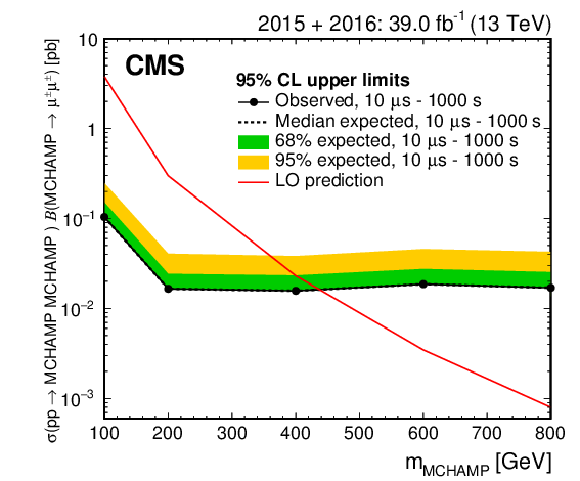
png pdf |
Figure 8-b:
95% CL upper limits on $\mathcal {B}\sigma $ for MCHAMP pair production as a function of mass, for lifetimes between 10 $\mu$s and 1000 s, for combined 2015 and 2016 data for the muon search. The theory curves assume $\mathcal {B}= $ 100%. |
| Tables | |

png pdf |
Table 1:
Summary of the values of $\varepsilon _{\text {stopping}}$, $\varepsilon _{\text {CSCveto}}$, $\varepsilon _{\text {DTveto}}$, and the plateau value of $\varepsilon _{\text {reco}}$ for different signals, for the calorimeter search. The efficiency $\varepsilon _{\text {stopping}}$ is constant for the range of signal masses considered. The efficiency $\varepsilon _{\text {reco}}$ is given on the $E_{{\mathrm {g}}}$ or $E_{{\mathrm {t}}}$ plateau for each signal. |

png pdf |
Table 2:
Gluino $\varepsilon _{\text {stopping}}$ and $\varepsilon _{\text {reco}}$, as well as the number of expected gluino events with lifetimes between 10 $\mu$s and 1000 s, assuming $\mathcal {B}(\tilde{\mathrm{g}}\to {\mathrm {q}} {\overline {\mathrm {q}}} \tilde{\chi}^0_2) \mathcal {B}(\tilde{\chi}^0_2 \to {{{\mu ^+}} {{\mu ^-}}} \tilde{\chi}^0_2)= $ 100%, for each mass point considered for the 2016 muon search. The efficiencies are constant for this range of lifetimes. |

png pdf |
Table 3:
MCHAMP $\varepsilon _{\text {stopping}}$ and $\varepsilon _{\text {reco}}$, as well as the number of expected MCHAMP events with lifetimes between 10 $\mu$s and 1000 s, assuming $\mathcal {B}(\text {MCHAMP} \to \mu ^{\pm}\mu ^{\pm})= $ 100%, for each mass point considered for the 2016 muon search. The efficiencies are constant for this range of lifetimes. |

png pdf |
Table 4:
The background prediction for the calorimeter search. The total background median value is listed in parentheses; this value corresponds directly to the median expected limits shown below. |

png pdf |
Table 5:
Systematic uncertainties in the signal efficiency in the 2015 and 2016 calorimeter searches. |

png pdf |
Table 6:
Systematic uncertainties in the signal efficiency for the 2015 and 2016 muon searches. |
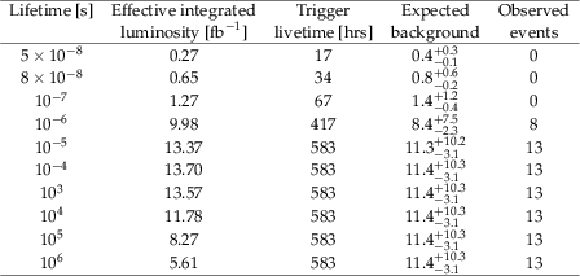
png pdf |
Table 7:
Counting experiment results for different lifetimes in the calorimeter search with 2016 data. |

png pdf |
Table 8:
Counting experiment results for different lifetimes in the muon search with 2016 data. |
| Summary |
|
A search has been presented for long-lived particles that stopped in the CMS detector after being produced in proton-proton collisions at a center-of-mass energy of 13 TeV at the CERN LHC. The subsequent decays of these particles to produce calorimeter deposits or muon pairs were looked for during gaps between proton bunches in the LHC beams. In the calorimeter (muon) search, with collision data corresponding to an integrated luminosity of 2.7\,(2.8) fb$^{-1}$ in a period of sensitivity corresponding to 135\,(155) hours of trigger livetime in 2015 and to an integrated luminosity of 35.9\,(36.2) fb$^{-1}$ in a period of sensitivity of 586\,(589) hours of trigger livetime in 2016, no excess above the estimated background has been observed. Cross section ($\sigma$) and mass limits have been presented at 95% confidence level (CL) on gluino (${\mathrm{\widetilde{g}}}$), top squark ($\tilde{\mathrm{t}}$), and multiply charged massive particle (MCHAMP) production over 13 orders of magnitude in the mean proper lifetime of the stopped particle. In the calorimeter search, combining the results from the 2015 and 2016 analyses and assuming a branching fraction ($\mathcal{B}$) of 100% for ${\mathrm{\widetilde{g}}} \to \mathrm{g}\tilde{\chi}^0$ (${\mathrm{\widetilde{g}}} \to \mathrm{q}\mathrm{\bar{q}}\tilde{\chi}^0$), where $\tilde{\chi}^0$ is the lightest neutralino, gluinos with lifetimes from 10 $mu$s to 1000 s and $m_{{\mathrm{\widetilde{g}}}} < $ 1385 (1393) GeV have been excluded, for a cloud model of R-hadron interactions and for the daughter gluon energy $E_{\mathrm{g}} > $ 130 GeV ($m_{{\mathrm{\widetilde{g}}}}-m_{\tilde{\chi}^0} > $ 160 GeV). Under similar assumptions, for the daughter top quark energy $E_{\mathrm{q}t} > $ 170 GeV and $\mathcal{B}(\tilde{\mathrm{t}} \to \mathrm{q}t\tilde{\chi}^0) = $ 100%, long-lived top squarks with lifetimes from 10 $\mu$s to 1000 s and $m_{\tilde{\mathrm{t}}} < $ 744 GeV have been excluded. These are the first limits on stopped long-lived particles at 13 TeV and the strongest limits to date. In the muon search, 95% CL upper limits on $\mathcal{B}\sigma$ were set for combined 2015 and 2016 data. For lifetimes between 10 $\mu$s and 1000 s, limits were set between 1 and 0.01 pb for gluinos with masses between 400 and 1600 GeV and for MCHAMPs with masses between 100 and 800 GeV and charge $| Q | = $ 2e. For lifetimes between 10 $\mu$s and 1000 s, gluinos with masses between 400 and 980 GeV have been excluded, assuming $\mathcal{B}({\mathrm{\widetilde{g}}} \to \mathrm{q}\mathrm{\bar{q}}\tilde{\chi}^0_2) \mathcal{B}(\tilde{\chi}^0Dt \to \mu^+\mu^-\tilde{\chi}^0)= $ 100%, $m_{\tilde{\chi}^0} = 0.25m_{{\mathrm{\widetilde{g}}}}$, and $m_{\tilde{\chi}^0Dt} = 2.5m_{\tilde{\chi}^0}$, where $\tilde{\chi}^0_2$ is the next-to-lightest neutralino. Under the same lifetime hypothesis, MCHAMPs with masses between 100 and 440 GeV and $| Q | = $ 2e have been excluded, assuming $\mathcal{B}(\text{MCHAMP} \to \mu^{\pm}\mu^{\pm})= $ 100%. These are the first limits obtained at the LHC for stopped particles that decay to muons. |
| References | ||||
| 1 | S. Dimopoulos, M. Dine, S. Raby, and S. D. Thomas | Experimental signatures of low-energy gauge mediated supersymmetry breaking | PRL 76 (1996) 3494 | hep-ph/9601367 |
| 2 | H. Baer, K.-M. Cheung, and J. F. Gunion | A heavy gluino as the lightest supersymmetric particle | PRD 59 (1999) 075002 | hep-ph/9806361 |
| 3 | T. Jittoh, J. Sato, T. Shimomura, and M. Yamanaka | Long life stau in the minimal supersymmetric standard model | PRD 73 (2006) 055009 | hep-ph/0512197 |
| 4 | M. Fairbairn et al. | Stable massive particles at colliders | PR 438 (2007) 1 | hep-ph/0611040 |
| 5 | M. J. Strassler and K. M. Zurek | Echoes of a hidden valley at hadron colliders | PLB 651 (2007) 374 | hep-ph/0604261 |
| 6 | A. Arvanitaki et al. | Astrophysical probes of unification | PRD 79 (2009) 105022 | 0812.2075 |
| 7 | N. Arkani-Hamed and S. Dimopoulos | Supersymmetric unification without low energy supersymmetry and signatures for fine-tuning at the LHC | JHEP 06 (2005) 073 | hep-th/0405159 |
| 8 | A. Arvanitaki, N. Craig, S. Dimopoulos, and G. Villadoro | Mini-split | JHEP 02 (2013) 126 | 1210.0555 |
| 9 | A. Arvanitaki et al. | Stopping gluinos | PRD 76 (2007) 055007 | hep-ph/0506242 |
| 10 | P. W. Graham, K. Howe, S. Rajendran, and D. Stolarski | New measurements with stopped particles at the LHC | PRD 86 (2012) 034020 | 1111.4176 |
| 11 | CMS Collaboration | Search for decays of stopped long-lived particles produced in proton-proton collisions at $ \sqrt{s} = $ 8 TeV | EPJC 75 (2015) 151 | CMS-EXO-12-036 1501.05603 |
| 12 | D0 Collaboration | Search for stopped gluinos from $ p\bar{p} $ collisions at $ \sqrt{s}= $ 1.96 TeV | PRL 99 (2007) 131801 | 0705.0306 |
| 13 | CMS Collaboration | Search for stopped long-lived particles produced in pp collisions at $ \sqrt{s}= $ 7 TeV | JHEP 08 (2012) 026 | CMS-EXO-11-020 1207.0106 |
| 14 | CMS Collaboration | Search for stopped gluinos in pp collisions at $ \sqrt{s}= $ 7 TeV | PRL 106 (2011) 011801 | CMS-EXO-10-003 1011.5861 |
| 15 | ATLAS Collaboration | Search for decays of stopped, long-lived particles from 7 TeV pp collisions with the ATLAS detector | EPJC 72 (2012) 1 | 1201.5595 |
| 16 | ATLAS Collaboration | Search for long-lived stopped $ R $-hadrons decaying out of time with $ pp $ collisions using the ATLAS detector | PRD 88 (2013) 112003 | 1310.6584 |
| 17 | M. Khlopov, C. A. Stephan, and D. Fargion | Dark matter with invisible light from heavy double charged leptons of almost-commutative geometry? | Class. Quant. Grav. 23 (2006) 7305 | astro-ph/0511789 |
| 18 | A. D. R\'ujula, S. L. Glashow, and U. Sarid | Charged dark matter | NPB 333 (1990) 173 | |
| 19 | S. Dimopoulos, D. Eichler, R. Esmailzadeh, and G. D. Starkman | Getting a charge out of dark matter | PRD 41 (1990) 2388 | |
| 20 | P. Langacker and G. Steigman | Requiem for a fractionally charged, massive particle | PRD 84 (2011) 065040 | 1107.3131 |
| 21 | ATLAS Collaboration | Search for heavy long-lived charged particles with the ATLAS detector in $ pp $ collisions at $ \sqrt{s} = $ 7 TeV | PLB 703 (2011) 428 | 1106.4495 |
| 22 | ATLAS Collaboration | Search for stable hadronising squarks and gluinos with the ATLAS experiment at the LHC | PLB 701 (2011) 1 | 1103.1984 |
| 23 | ATLAS Collaboration | Search for massive long-lived highly ionising particles with the ATLAS detector at the LHC | PLB 698 (2011) 353 | 1102.0459 |
| 24 | ATLAS Collaboration | Searches for heavy long-lived sleptons and R-hadrons with the ATLAS detector in pp collisions at $ \sqrt{s}= $ 7 TeV | PLB 720 (2013) 277 | 1211.1597 |
| 25 | ATLAS Collaboration | Search for long-lived, multi-charged particles in pp collisions at $ \sqrt{s}= $ 7 TeV using the ATLAS detector | PLB 722 (2013) 305 | 1301.5272 |
| 26 | ATLAS Collaboration | Search for heavy long-lived multi-charged particles in pp collisions at $ \sqrt{s}= $ 8 TeV using the ATLAS detector | EPJC 75 (2015) 362 | 1504.04188 |
| 27 | ATLAS Collaboration | Search for metastable heavy charged particles with large ionisation energy loss in pp collisions at $ \sqrt{s}= $ 8 TeV using the ATLAS experiment | EPJC 75 (2015) 407 | 1506.05332 |
| 28 | CMS Collaboration | Searches for long-lived charged particles in pp collisions at $ \sqrt{s}= $ 7 and 8 TeV | JHEP 07 (2013) 122 | CMS-EXO-12-026 1305.0491 |
| 29 | CMS Collaboration | Search for heavy stable charged particles in pp collisions at $ \sqrt{s}= $ 7 TeV | JHEP 03 (2011) 24 | CMS-EXO-10-011 1101.1645 |
| 30 | CMS Collaboration | Search for fractionally charged particles in pp collisions at $ \sqrt{s}= $ 7 TeV | PRD 87 (2013) 092008 | CMS-EXO-11-074 1210.2311 |
| 31 | CMS Collaboration | Search for heavy long-lived charged particles in pp collisions at $ \sqrt{s}= $ 7 TeV | PLB 713 (2012) 408 | CMS-EXO-11-022 1205.0272 |
| 32 | CMS Collaboration | Constraints on the pMSSM, AMSB model and on other models from the search for long-lived charged particles in proton--proton collisions at $ \sqrt{s} = $ 8 TeV | EPJC 75 (2015) 325 | CMS-EXO-13-006 1502.02522 |
| 33 | LHCb Collaboration | Search for long-lived heavy charged particles using a ring imaging Cherenkov technique at LHCb | EPJC 75 (2015) 595 | 1506.09173 |
| 34 | CMS Collaboration | Search for long-lived charged particles in proton-proton collisions at $ \sqrt{s}= $ 13 TeV | PRD 94 (2016) 112004 | CMS-EXO-15-010 1609.08382 |
| 35 | CMS Collaboration | The CMS experiment at the CERN LHC | JINST 3 (2008) S08004 | CMS-00-001 |
| 36 | R. Bailey and P. Collier | Standard filling schemes for various LHC operation modes | LHC-PROJECT-NOTE-323, CERN | |
| 37 | G. F. Giudice and A. Romanino | Split supersymmetry | NPB 699 (2004) 65 | hep-ph/0406088 |
| 38 | N. Arkani-Hamed, S. Dimopoulos, G. F. Giudice, and A. Romanino | Aspects of split supersymmetry | NPB 709 (2005) 3 | hep-ph/0409232 |
| 39 | D. Abercrombie et al. | Dark matter benchmark models for early LHC run-2 searches: report of the ATLAS/CMS dark matter forum | 1507.00966 | |
| 40 | L. M. Carpenter, R. Colburn, J. Goodman, and T. Linden | Indirect detection constraints on s and t channel simplified models of dark matter | PRD 94 (2016) 055027 | 1606.04138 |
| 41 | L. Covi and F. Dradi | Long-lived stop at the LHC with or without R-parity | JCAP 10 (2014) 039 | 1403.4923 |
| 42 | T. Sjostrand, S. Mrenna, and P. Skands | PYTHIA 6.4 physics and manual | JHEP 05 (2006) 026 | hep-ph/0603175 |
| 43 | T. Sjostrand, S. Mrenna, and P. Skands | A brief introduction to PYTHIA 8.1 | Comput. Phys. Comm. 178 (2008) 852 | 0710.3820 |
| 44 | GEANT4 Collaboration | GEANT4---a simulation toolkit | NIMA 506 (2003) 250 | |
| 45 | J. Allison et al. | Geant4 developments and applications | IEEE Trans. Nucl. Sci. 53 (2006) 270 | |
| 46 | P. Fayet | Spontaneously broken supersymmetric theories of weak, electromagnetic and strong interactions | PLB 69 (1977) 489 | |
| 47 | P. Fayet | Massive gluinos | PLB 78 (1978) 417 | |
| 48 | G. R. Farrar and P. Fayet | Phenomenology of the production, decay, and detection of new hadronic states associated with supersymmetry | PLB 76 (1978) 575 | |
| 49 | A. C. Kraan | Interactions of heavy stable hadronizing particles | EPJC 37 (2004) 91 | hep-ex/0404001 |
| 50 | R. Mackeprang and A. Rizzi | Interactions of coloured heavy stable particles in matter | EPJC 50 (2007) 353 | hep-ph/0612161 |
| 51 | CMS Collaboration | Identification and filtering of uncharacteristic noise in the CMS hadron calorimeter | JINST 5 (2010) T03014 | CMS-CFT-09-019 0911.4881 |
| 52 | M. Cacciari, G. P. Salam, and G. Soyez | The anti-$ k_t $ jet clustering algorithm | JHEP 04 (2008) 063 | 0802.1189 |
| 53 | M. Cacciari, G. P. Salam, and G. Soyez | FastJet user manual | EPJC 72 (2012) 1896 | 1111.6097 |
| 54 | CMS Collaboration | Performance of CMS muon reconstruction in pp collision events at $ \sqrt{s} = $ 7 TeV | JINST 7 (2012) P10002 | CMS-MUO-10-004 1206.4071 |
| 55 | CMS Collaboration, G. Abbiendi | The CMS muon system in Run2: preparation, status and first results | in Proceedings, 2015 European Physical Society Conference on High Energy Physics (EPS-HEP 2015): Vienna, Austria, July 22-29, 2015, p. 237 2015 [PoS(EPS-HEP2015)237] | 1510.05424 |
| 56 | P. Biallass and T. Hebbeker | Parametrization of the cosmic muon flux for the generator CMSCGEN | 0907.5514 | |
| 57 | D. Heck et al. | CORSIKA: A Monte Carlo code to simulate extensive air showers | FZKA-6019 | |
| 58 | CMS Collaboration | Measurement of the charge ratio of atmospheric muons with the CMS detector | PLB 692 (2010) 83 | CMS-MUO-10-001 1005.5332 |
| 59 | CMS Collaboration | Measurements of inclusive W and Z cross sections in pp collisions at $ \sqrt{s} = $ 7 TeV | JHEP 01 (2011) 080 | CMS-EWK-10-002 1012.2466 |
| 60 | M. J. Oreglia | A study of the reactions $\psi' \to \gamma\gamma \psi$ | PhD thesis, Stanford University, 1980 SLAC Report SLAC-R-236, see Appendix D | |
| 61 | L. Landau | On the energy loss of fast particles by ionization | J. Phys. (USSR) 8 (1944)201 | |
| 62 | CMS Collaboration | CMS luminosity measurement for the 2015 data taking period | CMS-PAS-LUM-15-001 | CMS-PAS-LUM-15-001 |
| 63 | CMS Collaboration | CMS luminosity measurements for the 2016 data taking period | CMS-PAS-LUM-17-001 | CMS-PAS-LUM-17-001 |
| 64 | CMS Collaboration | Performance of the CMS hadron calorimeter with cosmic ray muons and LHC beam data | JINST 5 (2010) T03012 | CMS-CFT-09-009 0911.4991 |
| 65 | CMS Collaboration, M. Schroder | Performance of jets at CMS | in Proceedings, 16th Int. Conf. on Calorimetry in HEP (CALOR 2014), volume 587, p. 012004 Giessen, Germany, April, 2015 [J. Phys. Conf. Ser. 587 (2015) 012004] | |
| 66 | T. Junk | Confidence level computation for combining searches with small statistics | NIMA 434 (1999) 435 | hep-ex/9902006 |
| 67 | A. L. Read | Presentation of search results: the $ CL_s $ technique | in Durham IPPP Workshop: Advanced Statistical Techniques in Particle Physics, p. 2693 Durham, UK, March, 2002 [JPG 28 (2002) 2693] | |
| 68 | R. D. Cousins and V. L. Highland | Incorporating systematic uncertainties into an upper limit | NIMA 320 (1992) 331 | |

|
Compact Muon Solenoid LHC, CERN |

|

|

|

|

|

|